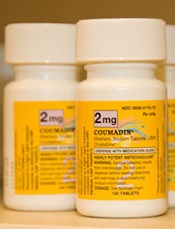
Photo courtesy of NIGMS
Many patients with atrial fibrillation (AF) who are at the highest risk of stroke are not receiving the recommended oral anticoagulant therapy, according to a new study.
Researchers did find that AF patients who had a higher risk of stroke according to CHADS2 score or CHA2DS2-VASc score were more likely to receive an oral anticoagulant.
But the prevalence of oral anticoagulant use did not exceed 50%, even among high-risk patients.
Jonathan C. Hsu, MD, of the University of California, San Diego, and his colleagues reported these findings in JAMA Cardiology.
The researchers said it has not been clear if the prescription of oral anticoagulants increases as the risk of stroke increases in AF patients.
To gain some insight, the team studied 429,417 outpatients with AF enrolled in the American College of Cardiology National Cardiovascular Data Registry’s PINNACLE Registry between January 2008 and December 2012.
The researchers calculated the CHADS2 score and the CHA2DS2-VASc score for all patients and examined the association between increased stroke risk score and prescription of an oral anticoagulant.
In the entire cohort, 44.9% of patients were prescribed an oral anticoagulant, 25.9% aspirin only, 5.5% aspirin plus a thienopyridine, and 23.8% no antithrombotic therapy.
The researchers found that each 1-point increase in risk score was associated with increased odds of oral anticoagulant prescription when compared with aspirin-only prescription.
When using CHADS2 score, the adjusted odds ratio was 1.158 (95% CI, 1.144-1.172, P<0.001). When using CHA2DS2-VASc score, the adjusted odds ratio was 1.163 (95% CI, 1.157-1.169, P<0.001).
Still, the researchers said they observed a plateau in oral anticoagulant prescription.
The prevalence of oral anticoagulant prescription did not exceed 50%, even in patients with a CHADS2 score exceeding 3 or a CHA2DS2-VASc score exceeding 4.
Dr Hsu and his colleagues said these findings draw attention to important gaps in the appropriate treatment of patients with AF at the highest risk of stroke and highlight opportunities to understand the reasons behind these gaps.


